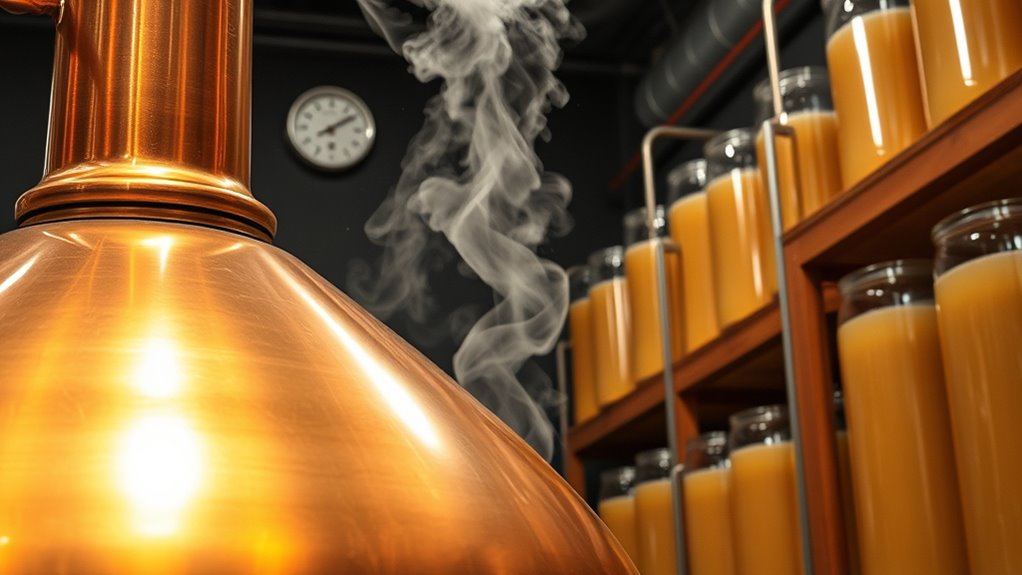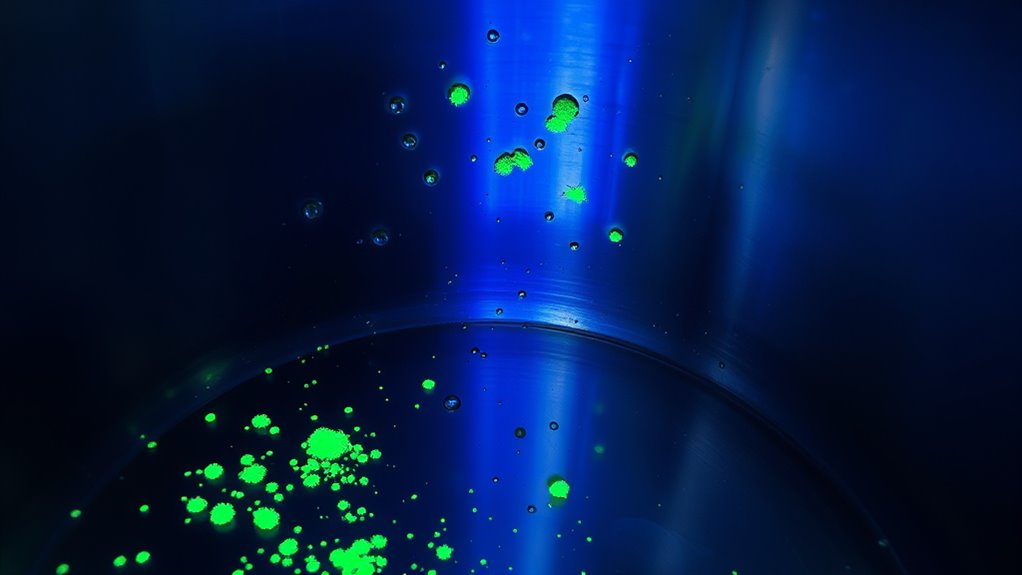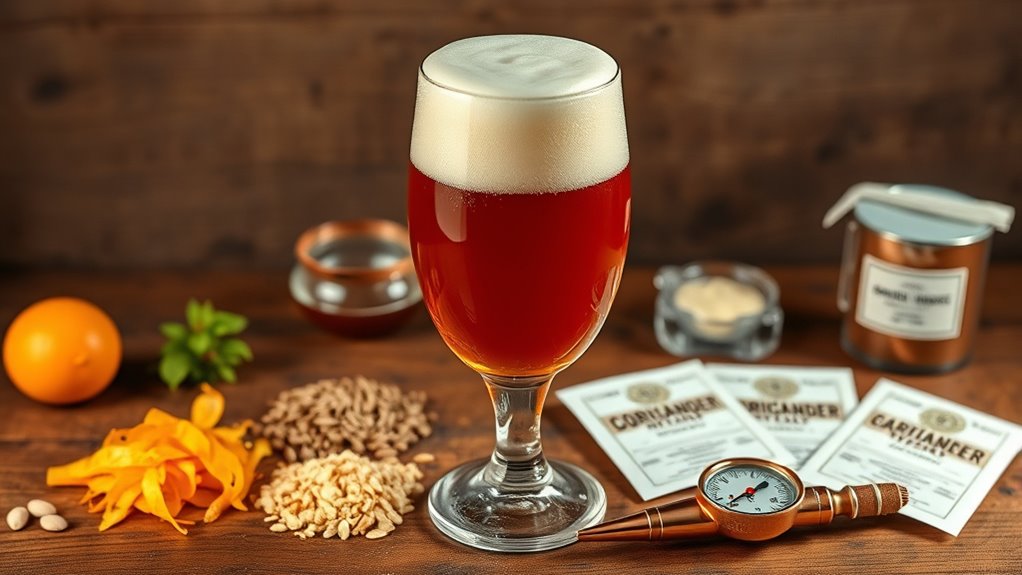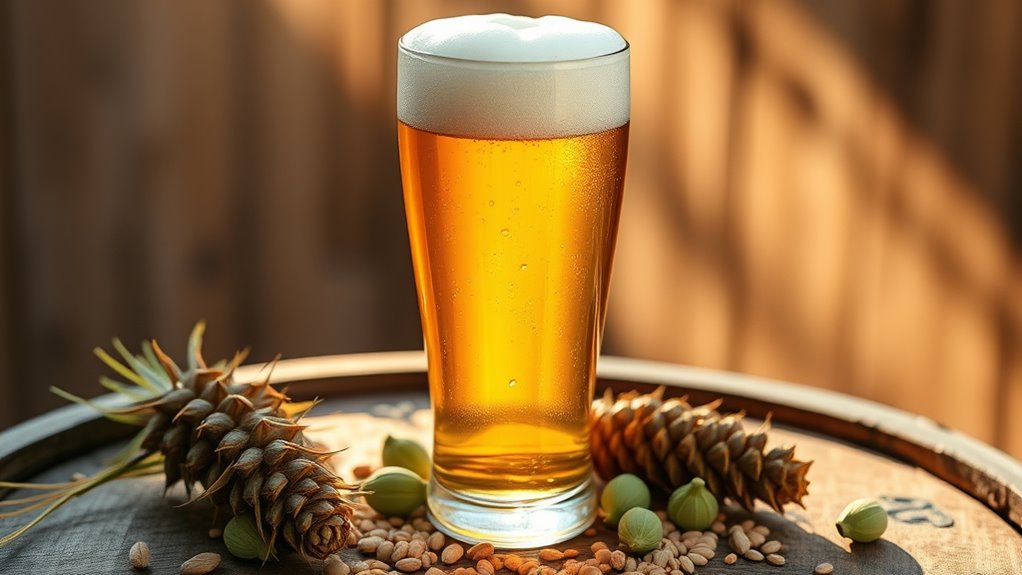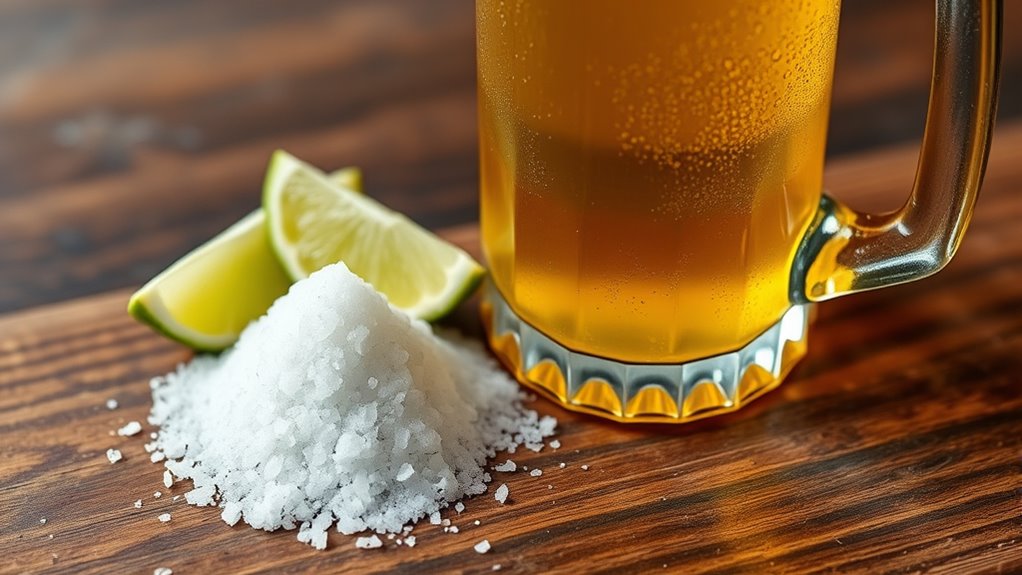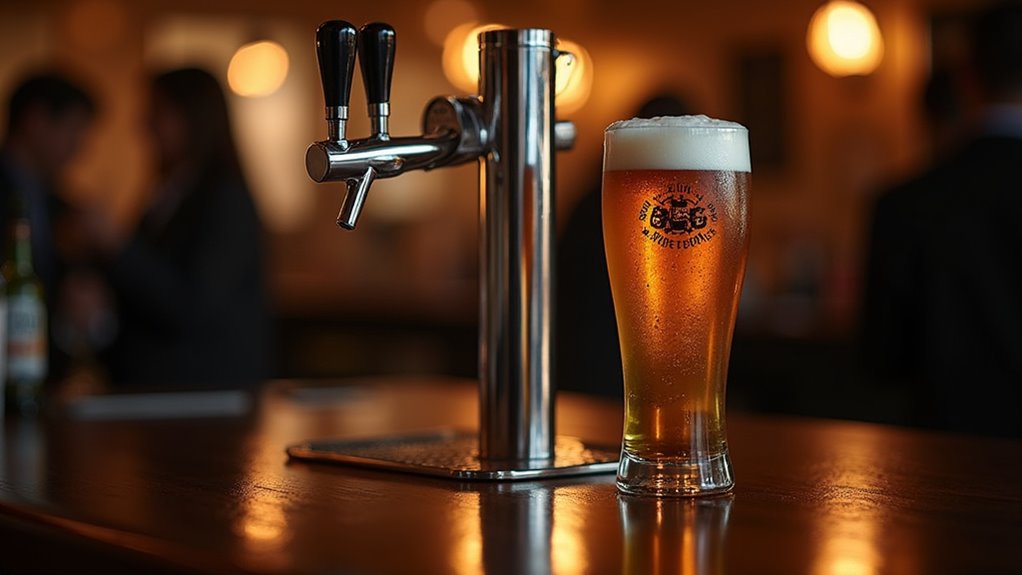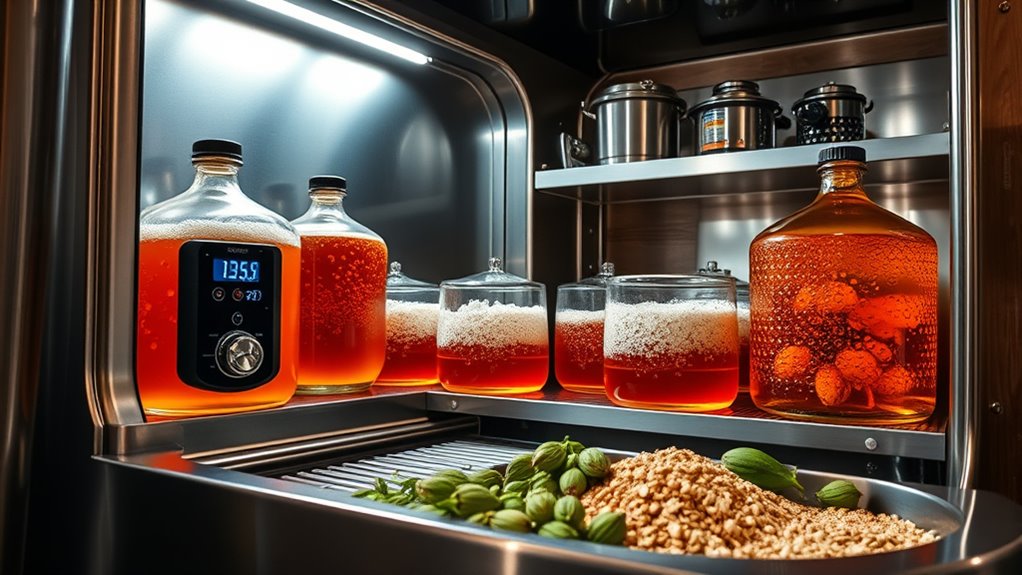To brew authentic German lager styles, first, select high-quality ingredients like Weyermann malts and fresh Hallertauer hops. Create a yeast starter and maintain fermentation temperatures between 50° F and 54° F. Use mashing techniques, such as a standard 60-minute mash at 153-156°F, to enhance flavors. Control water chemistry by removing chlorine and adjusting brewing salts for desired profiles. Finally, monitor and record fermentation progress. Next, you’ll discover detailed brewing processes and techniques essential for perfection.
At a Glance
- Use high-quality German malts like Weyermann Pilsner and Munich for authentic flavor profiles in your lagers.
- Maintain fermentation temperatures between 50° F (10° C) and 54° F (12° C) for optimal yeast performance.
- Conduct a diacetyl rest at 57° F (14° C) to eliminate unwanted flavors during fermentation.
- Monitor mash pH to achieve optimal enzymatic activity, aiming for a range between 5.2 and 5.4.
- Incorporate specific brewing salts based on desired flavor profiles, such as calcium sulfate for hop-forward beers.
Selecting Quality Ingredients
When brewing German lager styles, selecting quality ingredients is vital for achieving authentic flavors and aromas.
Start with high-quality German malts like Weyermann Pilsner and Munich, essential for creating rich flavor profiles. For a Dunkel, consider a grain bill with 4.5 lb Pilsner and 5.5 lb Munich II. Incorporate fresh hops, such as Hallertauer Tradition, to enhance the lager’s character. Using a quality base malt like Munich can add depth and complexity to your brews.
Don’t overlook yeast; opt for strains like Wyeast Bavarian Lager 2206. Finally, guarantee ideal water chemistry by adding brewing salts, like 2 grams of calcium sulfate for hop-forward beers, to elevate the quality of your brew.
Helpful Hints
- Source ingredients locally when possible.
- Maintain yeast health with proper pitching rates.
- Experiment with brewing salts for flavor enhancement.
Understanding Yeast and Fermentation
To achieve the distinct flavors and aromas characteristic of German lagers, it’s essential to grasp the role of yeast and the fermentation process.
Start by creating a yeast starter with 1 liter of water, 0.12 liters of dry malt extract, and 3 grams of yeast nutrient. Use lager yeast and maintain fermentation temperatures between 50° F (10° C) and 54° F (12° C).
Once fermentation nears completion, conduct a diacetyl rest at 57° F (14° C) to eliminate off-flavors. Keep accurate records of yeast strains, fermentation temperatures, and durations, typically 8-12 days, to improve your brewing process over time. Proper yeast management practices are crucial to achieving optimal fermentation results.
Helpful Hints:
- Prioritize temperature control.
- Allow at least 35 days for aging.
The Importance of Mashing Techniques
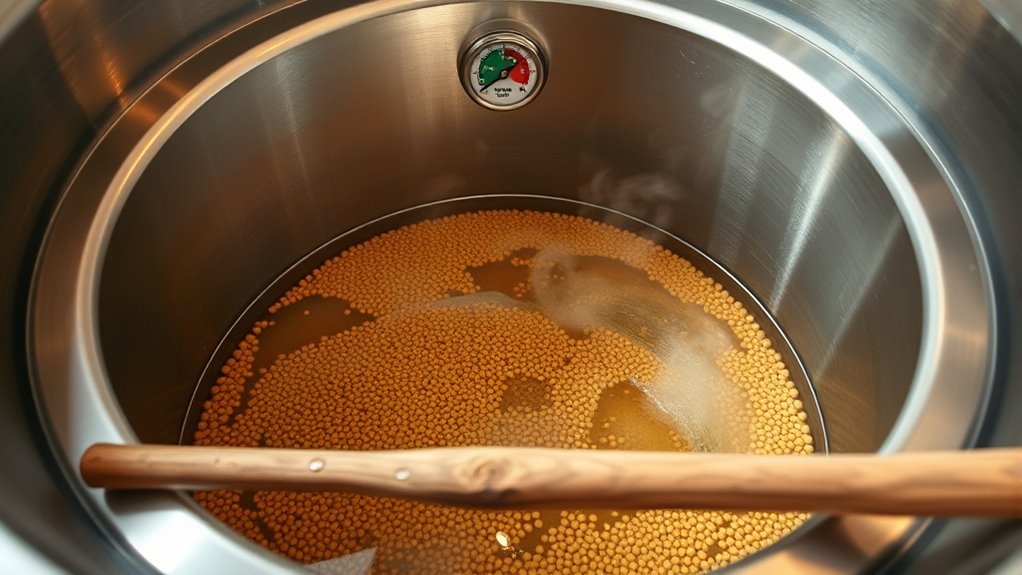
Mashing techniques are critical in the brewing process, as they directly influence the beer’s body, sweetness, and overall flavor profile. To achieve desired results, maintain a mashing temperature between 153-156°F (67-69°C) for maltier beers.
A standard mash duration of 60 minutes maximizes enzyme activity, converting starches into fermentable sugars efficiently. Consider raising the temperature to 160°F (71°C) by adding hot water, enhancing mash efficiency.
Techniques like decoction mashing can create unique flavor profiles through varying temperature steps. Remember, mastering these techniques will greatly elevate your brewing craft and the quality of your authentic German lagers. Additionally, it is essential to monitor mash pH since it impacts enzyme activity and overall beer quality.
Helpful Hints:
- Experiment with mashing temperatures for different styles.
- Monitor mash duration closely for maximum enzyme activity.
- Adjust your process based on desired flavor profiles.
Water Chemistry and Brewing Salts
Water chemistry plays an essential role in brewing authentic German lagers, as it directly affects the beer’s flavor, mouthfeel, and overall quality.
Start with a clean base by using a carbon filter to remove chlorine and heavy metals from your brewing water. To fine-tune your water chemistry, add brewing salts: 2 grams of calcium sulfate for hop-focused beers and 1.5 grams of calcium chloride for maltier styles during the mash. It’s important to consider the sulfate-to-chloride ratio when selecting your brewing salts, as this can significantly impact the flavor profile of your beer.
Monitor your pH, aiming for a range between 5.2 and 5.4, to optimize enzymatic activity and enhance malt flavor during fermentation. Precision leads to excellence.
Helpful Hints:
- Test your water regularly.
- Adjust salts based on desired flavor profiles.
Step-by-Step Brewing Process
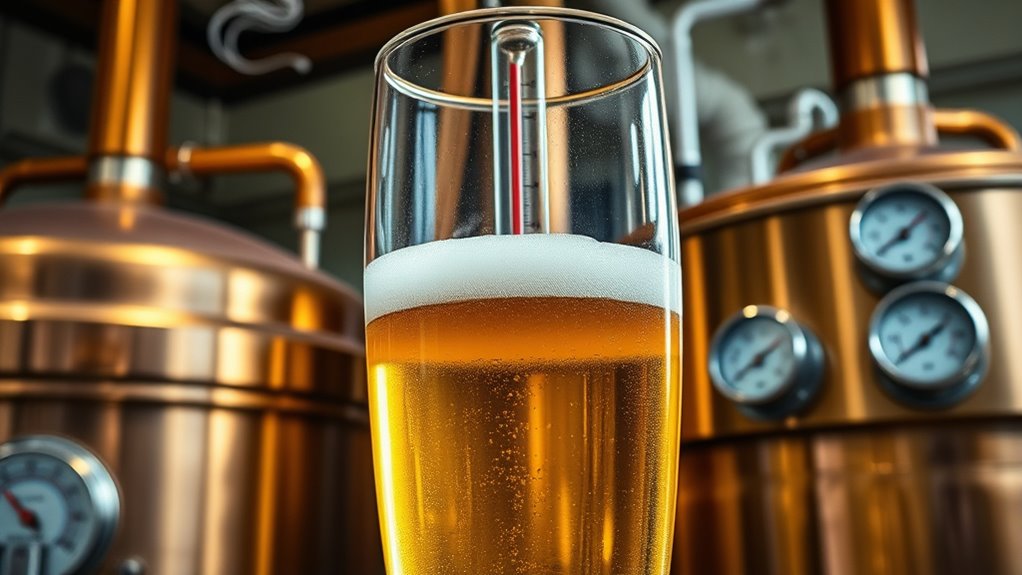
Brewing German lagers involves a systematic process that begins once your water chemistry is dialed in.
Start by heating your water to 15°F (8°C) above your target mash temperature, then maintain the mash at 153-156°F (67-69°C) for 60 minutes.
Begin by heating your water 15°F above your target mash temperature, then hold the mash at 153-156°F for an hour.
Raise the temperature to 160°F (71°C) with hot water.
Create a yeast starter using a mix of water, dry malt extract, and yeast nutrient, boiling it for 15 minutes and cooling it to 50°F (10°C).
Ferment at 50°F (10-12°C) for 8-12 days, then raise to 57°F (14°C) for a diacetyl rest, ensuring a balanced flavor profile and potential alcohol.
Carbonation and Packaging
As you move into the carbonation and packaging phase, it’s essential to verify that your lager maintains its crisp and invigorating character.
Follow these steps for best results:
- Confirm all equipment is clean by using PBW with 120° F water and sanitizing with Star San.
- When kegging, purge vessels with CO2 to prevent oxidation.
- Filter lager beer into a clean vessel, connect to CO2 at 10 PSI, and rock the keg for four minutes at 30° F.
- For bottling, use fresh yeast with a priming solution, allowing carbonation to develop over 1 to 2 months.
Additionally, ensure that all surfaces and vessels are sanitized to minimize the risk of wild yeast contamination that can spoil the lager’s flavor and stability.
Evaluating and Tasting Your Beer
How can you effectively evaluate and taste your German lagers to guarantee they meet your expectations?
Start by developing a technical palate through regular tastings of various styles. Focus on evaluating the aroma, flavor, mouthfeel, and aftertaste, noting discrepancies from expected characteristics, like the clean finish of Pilsners.
Use SRM and IBU measurements to assess color and bitterness. Engage in comparative tastings with commercial examples to benchmark flavors and aromas.
Finally, keep detailed tasting notes documenting your sensory observations and any brewing adjustments. This practice will refine your techniques, ensuring you achieve the desired results in future batches. Additionally, consider monitoring fermentation activity rate to understand how it affects flavor development in your brews.
Common German Lager Styles
German lagers encompass a variety of styles, each offering distinct flavors and characteristics that cater to different tastes.
German lagers offer a diverse range of styles, each with unique flavors and characteristics to satisfy various palates.
Here are some common German beer styles you should know:
- Munich Helles: A malt-driven lager that’s easy to drink, with a sweeter profile and less hop bitterness than Pilsner.
- German Pilsner: Lighter and drier, this style features a crisp, floral aroma with a slightly bitter finish.
- Bock beers: Ranging from light to dark, these beers showcase rich, toasty flavors, often enjoyed during celebrations.
- Dunkel and Schwarzbier: Dark lagers with roasted malt notes, offering unique sweetness and restrained bitterness, respectively.
Explore these styles to enhance your brewing experience!
